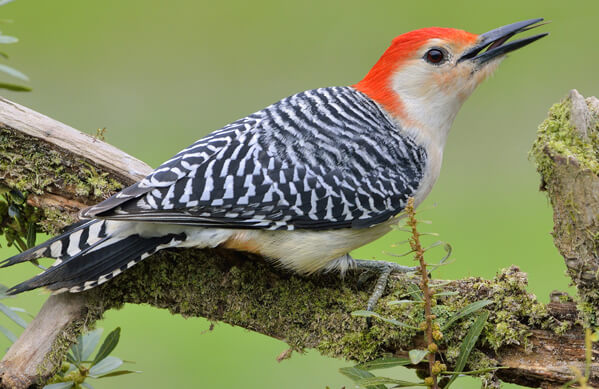Experiencing Woodpeckers in Florida Species: Habitats and Actions
Experiencing Woodpeckers in Florida Species: Habitats and Actions
Blog Article
Woodpeckers: A Comprehensive Guide to Understanding These Unique Birds
Woodpeckers, with their unique actions and physical attributes, have long astounded the curiosity of ornithologists and nature fanatics alike. As we explore the detailed composition, varied types, and eco-friendly importance of woodpeckers, a much deeper gratitude for these unique birds and the mysteries they hold unravels.

Woodpeckers' Drumming Actions
Woodpeckers show a balanced and specific drumming actions that offers numerous essential functions in their lives. This actions is primarily related to interaction, region protection, and foraging. The distinct drumming noise is produced by the fast pecking of their beaks against difficult surfaces such as tree trunks, branches, and even steel things.
Communication is an important element of woodpecker behavior, and drumming plays a significant duty in this process. Woodpeckers make use of drumming to establish their existence, attract companions, and keep contact with their partners and offspring. The regularity, strength, and duration of drumming sequences share details messages to other woodpeckers in the area.
In addition to communication, woodpeckers utilize drumming behavior for area defense. Woodpeckers in Florida. The loud and repetitive drumming acts as a warning to potential burglars, signaling that the area is currently declared. By establishing their territory via drumming, woodpeckers decrease the likelihood of conflicts over beneficial resources such as food and nesting websites
Additionally, woodpeckers additionally employ drumming as a foraging strategy. The balanced pecking assists them locate bugs concealing underneath the bark of trees by creating resonances that interrupt the victim's concealment. This behavior showcases the flexibility and resourcefulness of woodpeckers in utilizing their drumming skills for multiple necessary functions.
Special Adjustments for Tree Climbing
Having understood the art of drumming to communicate, defend area, and forage, woodpeckers have advanced distinct adaptations that facilitate their exceptional climbing up capabilities in their arboreal environments. One crucial adjustment is their customized feet. Woodpeckers have zygodactyl feet, with 2 toes directing forward and 2 toes directing backwards. This setup provides a strong hold on the upright surfaces of trees, allowing them to stick easily while foraging for pests or drumming. Additionally, woodpeckers have rigid tail feathers that function as a prop to support their bodies as they climb. These tail feathers offer stability and equilibrium, making it possible for woodpeckers to steer up tree trunks with accuracy and dexterity.
Furthermore, woodpeckers have powerful neck muscular tissues and a distinct skull structure that help in their climbing capacities. Their solid neck muscles enable them to quickly peck at tree bark without experiencing whiplash, while their thick head and tiny brain work as shock absorbers, shielding them from the impact of repeated drumming. These adaptations collectively allow woodpeckers to navigate the upright globe of trees with efficiency and poise.

Function of Woodpeckers in Ecosystems
By foraging for bugs under the bark of trees, woodpeckers help control pest populaces, protecting against outbreaks that could harm the general health of the forest. Furthermore, woodpeckers develop dental caries in trees that offer as essential nesting sites for a selection of other bird species, promoting biodiversity within the environment.
In addition, the drumming and vocalizations of woodpeckers play a crucial role in communication and territory facility. These noises not only serve to draw in mates however also assist define limits in between different woodpecker territories, useful source reducing disputes and promoting a harmonious conjunction within the forest neighborhood. Generally, the visibility of woodpeckers in woodland ecosystems highlights their importance as keystone varieties, affecting the dynamics and working of these habitats in diverse means.
Composition: Specialized Beaks and Feet
In the detailed internet of forest communities, the specialized beaks and feet of woodpeckers are necessary adaptations that allow them to accomplish their critical ecological roles. Woodpeckers have special physiological features that are particularly designed to help them in their foraging and nesting behaviors.
One of the most distinguishing characteristic of woodpeckers is their strong, chisel-shaped beaks. These beaks are flawlessly adapted for boring right into wood to reveal bugs, larvae, and sap hidden underneath the bark of trees. The solid muscles and durable framework of their beaks allow woodpeckers to peck at a rate of approximately 20 times per secondly without causing damage to their heads.
Furthermore, woodpeckers have actually specialized feet that help in their acrobatic climbing capabilities. Their feet have 2 toes aiming forward and two toes directing backwards, giving a strong grip on vertical surfaces (Woodpeckers in Florida). This special foot setup, along with stiff tail feathers that function as an encouraging my site prop, permits woodpeckers to hold on to tree trunks and branches effortlessly while they browse for food or excavate nesting tooth cavities
Woodpecker Variety Variety
Woodpeckers are a diverse team of birds located across numerous ecological communities worldwide, with over 200 well-known types displaying adaptations to various settings. Woodpeckers have evolved to Read More Here inhabit an array of atmospheres, from forests and timberlands to meadows and deserts, each providing unique obstacles that have affected the development of distinct woodpecker varieties.
One more contributing variable to woodpecker types diversity is their specialized feeding actions. Different species have actually evolved to manipulate different food resources, such as pests, tree sap, fruits, and nuts, resulting in the development of certain adaptations in beak form, size, and toughness. These adaptations enable woodpeckers to forage effectively in their respective habitats, minimizing competition amongst types and promoting specific niche differentiation. Furthermore, geographic seclusion and historical variables have played a duty in shaping the circulation and diversity of woodpecker types, leading to the large array of specialized adjustments seen in these interesting birds.

Verdict
In final thought, woodpeckers are fascinating birds that display unique drumming actions, specialized adaptations for tree climbing, and play crucial roles in environments. With a diverse variety of woodpecker species discovered worldwide, these birds are essential for preserving the wellness and balance of woodlands and forests.
Report this page